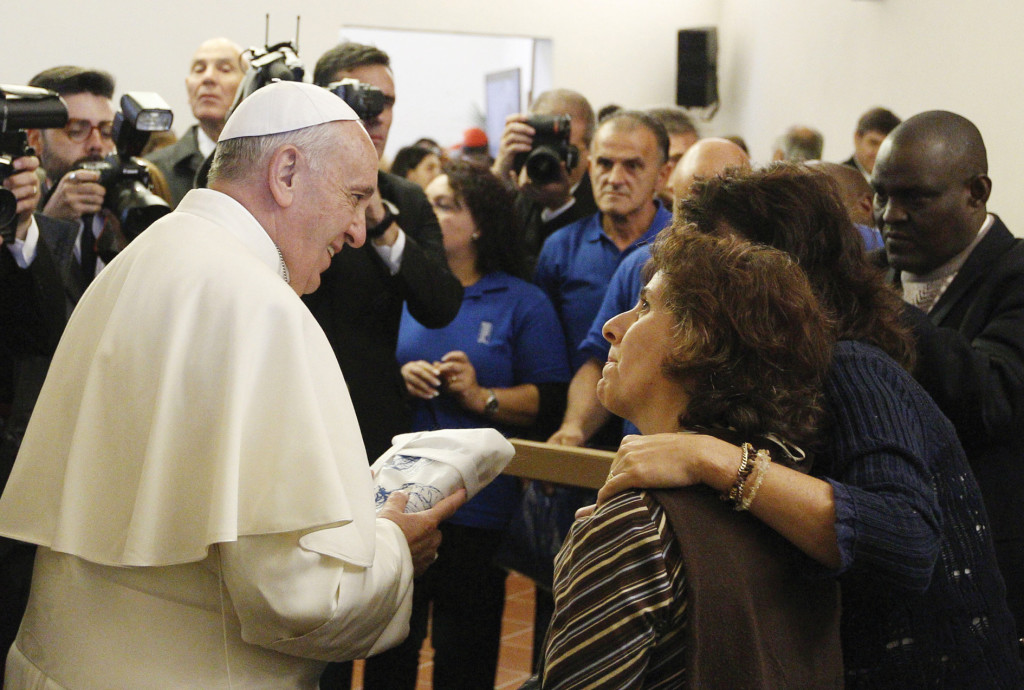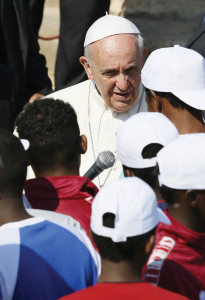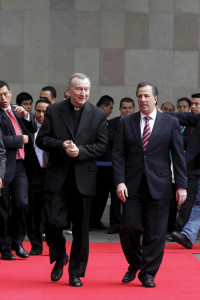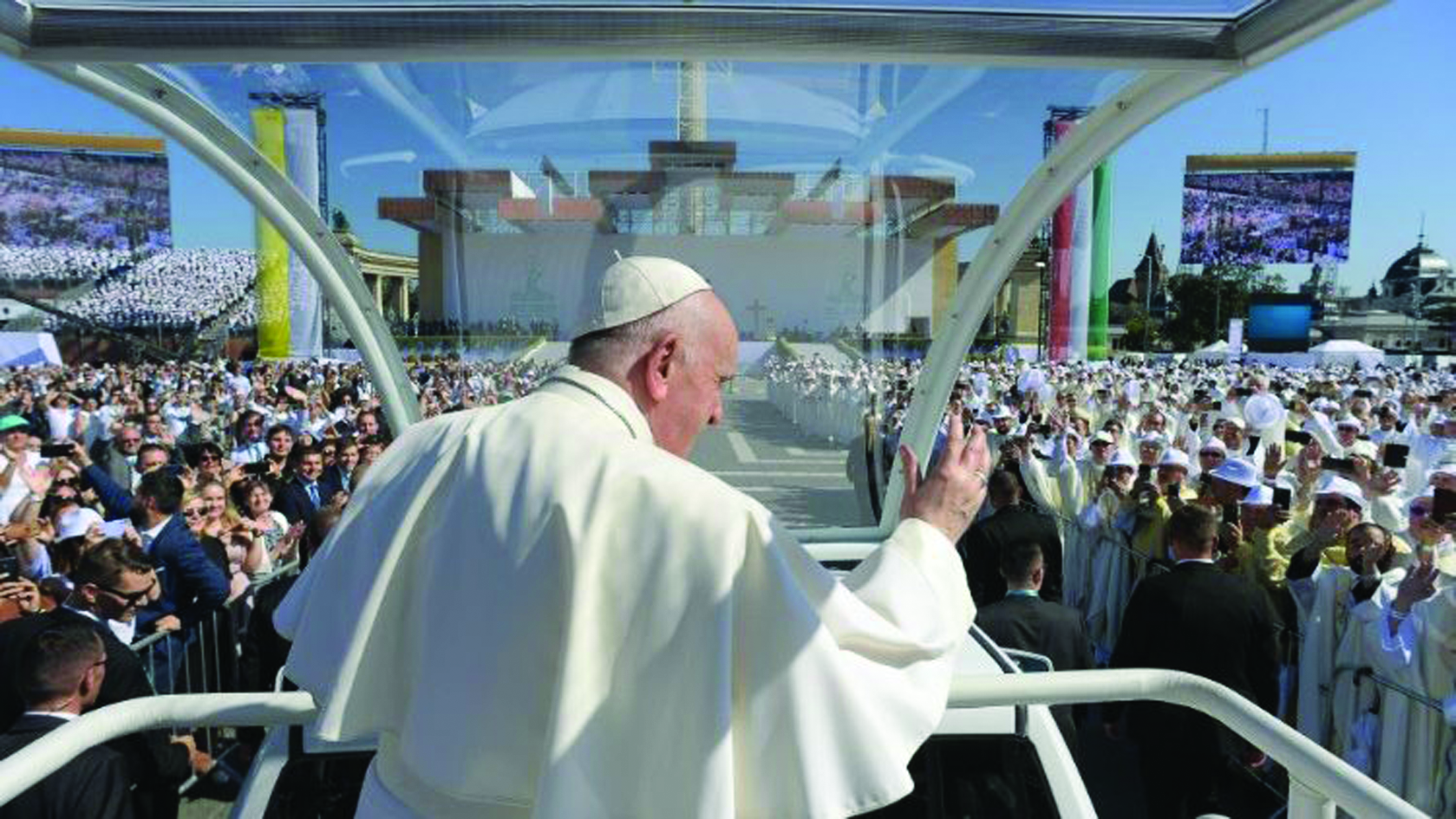
Pope Francis leads a meeting with the poor in the archbishop’s residence in Assisi, Italy, October 4, 2013. The meeting was in the famous “stripping room,” where St. Francis stripped off his rich clothes, gave them to his father and began a life of poverty dedicated to Christ (CNS photo/Paul Haring).
In his radio address of September 11, 1962, prior to the opening of the Second Vatican Council, St. John XXIII stated that “(…) the Church presents itself as she is and as she wishes to be, as the Church of all and especially the Church of the poor.” The Constitution Lumen Gentium, n. 8, affirms that “Christ was sent by the Father to bring the Good News to the poor and to lift up the downtrodden (Lc. 4, 18),” therefore for the Church “recognizes in the poor and in those who suffer the image of her Founder, poor and patient.” And when the Council concluded, an inspired group of Conciliar Fathers signed a document called the “Pact of the Catacombs” (because it was signed next to the catacombs of Domitilla, in Rome), a proposition to the Church and a personal commitment on the part of the signers to bear witness to poverty. Nevertheless, this critical sign of ecclesial self-awareness was not further developed or systematized in the conciliar documents. This was likely due to the concurrent economic “boom” experienced in Europe.
In the transition from theory (the preparation of the conciliar texts, in which the Latin American contributions were relatively few) to practice (implementation in Latin America), several urgent questions became immediately and acutely apparent: How could the renewal of the Church proceed in a continent with huge masses of people living in poverty, people who express their faith in God through their simple traditional expressions of piety? (Translator’s note: “religiosidad popular” is a difficult Spanish phrase to translate from Spanish referring to a way of expressing religious faith based less in philosophical and theological study than in traditional pious beliefs and practices).
How to speak of God to this multitude of the poor who see the Church as their home?

Pope Francis talks with immigrants at the port in Lampedusa, Italy, on July 8, 2013.
The Pope called for repentance over treatment of migrants as he visited the Italian island where massive numbers of Africans have landed in attempts to reach Europe (CNS photo/Paul Haring).
The concept of a “preferential love for the poor” has been an essential contribution of the Church in Latin America to Catholicism as a whole, drawing from Gospel teachings and from the great Catholic tradition this fundamental purpose of the Church’s existence, and of Christian existence. In his Apostolic Exhortation Evangelii Gaudium, n. 48, Pope Francis, citing Benedict XVI, reminds us that “the poor are the privileged recipients of the Gospel,” and states, “there is, unequivocally, an inseparable link between our faith and the poor.” In effect, “for the Church, the choice of the poor, before being a cultural, sociological, political or philosophical matter, is a theological one,” which expresses “a special type of priority in the exercise of Christian charity, to which the whole tradition of the Church gives testimony” (citing St. John Paul II in Sollicitudo Rei Socialis, n. 42). It is a choice that “is implicit in the Christological faith in a God who has become poor for us, enriching us through his poverty” (referring to the text of Pope Benedict XVI in his inaugural speech of the 5th General Conference of the Latin American Episcopate in Aparecida, 2007).
There is no older or better theological development of this “choice of the poor” in the magisterium of the current Church than that which is found in the document of Aparecida and in Evangelii Gaudium, taken together as communicative vessels. It is certain that this providential inspiration had to come to pass through many phases of arduous debate and discernment throughout the tumultuous and fertile history of the Church in Latin America during the post-conciliar era, in which it increasingly left behind a merely “welfarist” vision that did not sufficiently take into account the structural factors at the root of poverty as structural manifestations of human sin, as well as moving beyond an ideological vision characterized by the hermeneutics of class struggle. Also left behind was a moralist reduction of the Christian event, which does not recognize and value it as an example of freely-given charity—to adore and to serve!—but rather, would exploit it for political purposes.
This privileged love was so-called to embrace not only those who do not have bread, work, housing, or health, but also all those deprived of their human dignity, all those who suffer in their own flesh the “wounds” of the Lord. In this way everything was centered on the faces of the poor, images of Christ, whose cry moves God, rich in mercy, implores his charity and is cause for judgement for the lives of Christians and their communities. Because of this, Pope Francis warned in Assisi that one must never separate the imitation of Christ and love for the poor, so that this “choice” does not become increasingly worn out and contaminated ideologically and at last is undertaken as the activity of a Church that has become simply another NGO.
In this context, we must highlight the new categories of analysis that Archbishop Jorge Mario Bergoglio, now Pope Francis, has coined in order to make reference concretely to the “new slaves” of modern society or to those who are “thrown away” as “excess” waste. The poorest of the poor are typified, in their human and societal forms, by slaves and the marginalized.
This neo-slavery is proven, according to Bergoglio, by “the trafficking of human beings.” On July 13, 2010, in a homily, the Archbishop spoke out against human trafficking, stating that “Buenos Aires is a slave factory and a meat grinder (…) Please, let us not wash our hands of this, because if we do, we are accomplices in this slavery!” The new slaves are, among others, boys and girls subjected to all types of sexual abuse, exploited for labor or incorporated into organized begging networks and even used as drug runners; women enslaved for the purposes of prostitution or who suffer daily violence inside domestic walls, who are reduced to being “servants” to their “masters”; immigrants who are the targets of unscrupulous traffickers and who are obligated to accept miserable work and living conditions. Together with these slaves, the then-Cardinal Bergoglio (now Pope Francis) has denounced the “culture of waste” (“throwaway culture”) in which not only things but also people are considered “disposable,” “excess.” As he explains in Evangelii Gaudium, n. 53, it is not simply about the phenomenon of exploitation and oppression, but rather something new: “this exclusion affects in its very roots one’s belonging to the society in which one lives, as one is no longer within it, at the bottom, at the periphery, or without power, but rather outside entirely.” Those who are excluded are not simply “exploited,” but rather “excess,” waste products.
Also seen as waste material are the more than 40 million human beings eliminated annually through abortion, especially including, in the most brutal form of sexual discrimination, those of the female sex. These are “discarded” from the mother’s womb on the basis of all types of discrimination, given the eugenic tendency that is observed above all in societies with greater economic development. “The thought of the children who will never be able to see the light, victims of abortion, awakens horror” (ibid, 13.1.2014). “Abortion and infanticide are abominable crimes,” repeated Pope Francis, taking an expression from the Second Vatican Council. We may add to this all frozen eggs, discarded in the process of in vitro fertilization, destined to be destroyed or manipulated. Such is the neo-Malthusian and Darwinist tendency that the dominant culture creates and spreads.
Abandoned children living in the streets, youths who neither work nor are educated and for whom the only horizon is entrapment in networks of delinquency and drug trafficking, are also treated as disposable materials, as are the many jobless who see their human dignity undermined, drug addicts deprived of assistance, refugees who cannot return to the country from which they have come, who concentrate in encampments in multitudes of dispossessed, not received by any government, as well as the “great masses of the population that see themselves excluded and marginalized” (E.G. 53), migrants who are considered superfluous in their countries of origin, cartoneros, who collect used cardboard to re-sell it, who survive by working with garbage and feeding themselves from it, the abandoned elderly and infirm with whom, many times, “legal” or covert forms of euthanasia are put into practice. “The weakest are disposed of: children and the elderly,” observed Cardinal Bergoglio in his “Te Deum” homily on Argentina’s national holiday, May 25, 2012.
The question posed to Cain: “Where is your brother?” today is directed toward all of us: “Where is your brother enslaved, your brother discarded?”
Vatican to Support Help for “Humanitarian Emergency” of Child Migrants

Mexican Foreign Minister Jose Antonio Meade Kuribrena walks with Cardinal Pietro Parolin, Vatican Secretary of State, in Mexico City on July 13.
Cardinal Parolin traveled to Mexico to discuss the flow of child migrants from Central America with regional counterparts (CNS photo/courtesy of SRE).
The Vatican’s Secretary of State pledged full support for addressing the issue of child migrants streaming out of Central America in search of safety and family reunification in the United States. Pope Francis, meanwhile, described the situation a “humanitarian emergency” and called for the international community to act.
Speaking at the Mexico’s Foreign Relations Secretariat on July 14, Cardinal Pietro Parolin repeated a recent call of bishops in five countries for Catholics and society at large to lend a helping hand for the thousands of young migrants traveling through Mexico and often arriving unaccompanied in the United States. “Given these migratory facts, we urgently need to overcome primitive misgivings and again propose common strategies at the subregional, regional and world levels that include all sectors of society,” Parolin said in a speech attended by clergy and the foreign ministers of Mexico, Guatemala, El Salvador and Honduras. “Their numbers grow daily exponentially,” he said of the Central Americans abandoning their countries. “Whether they travel for reasons of poverty, violence or the hope of uniting with families on the other side of the border, it is urgent to protect and assist them.” —(CNS)






Facebook Comments